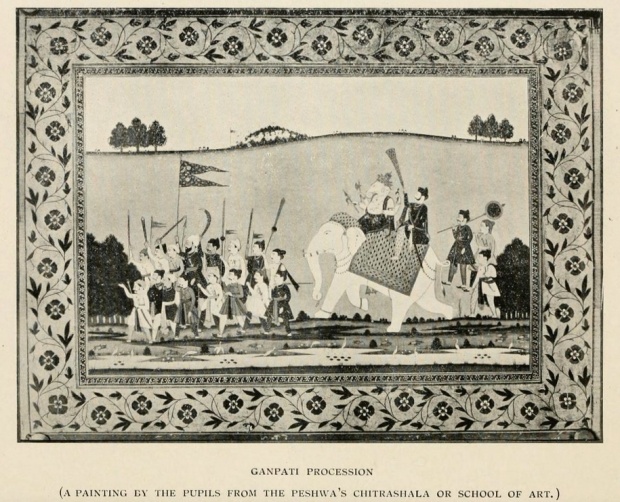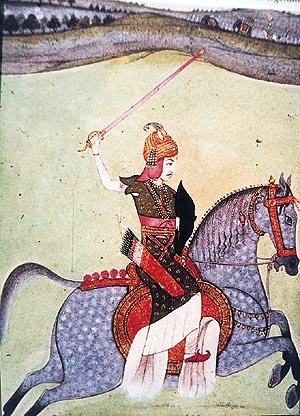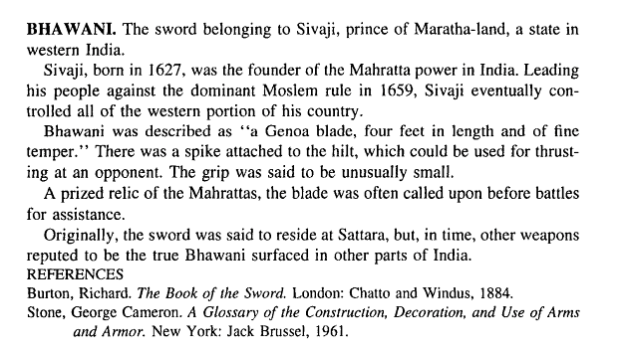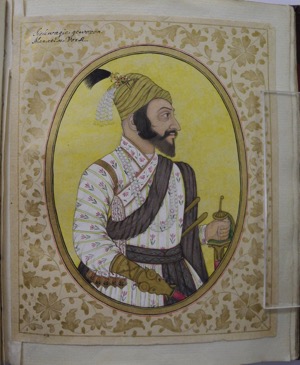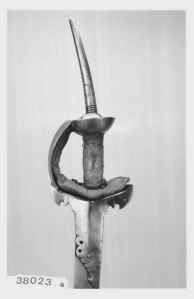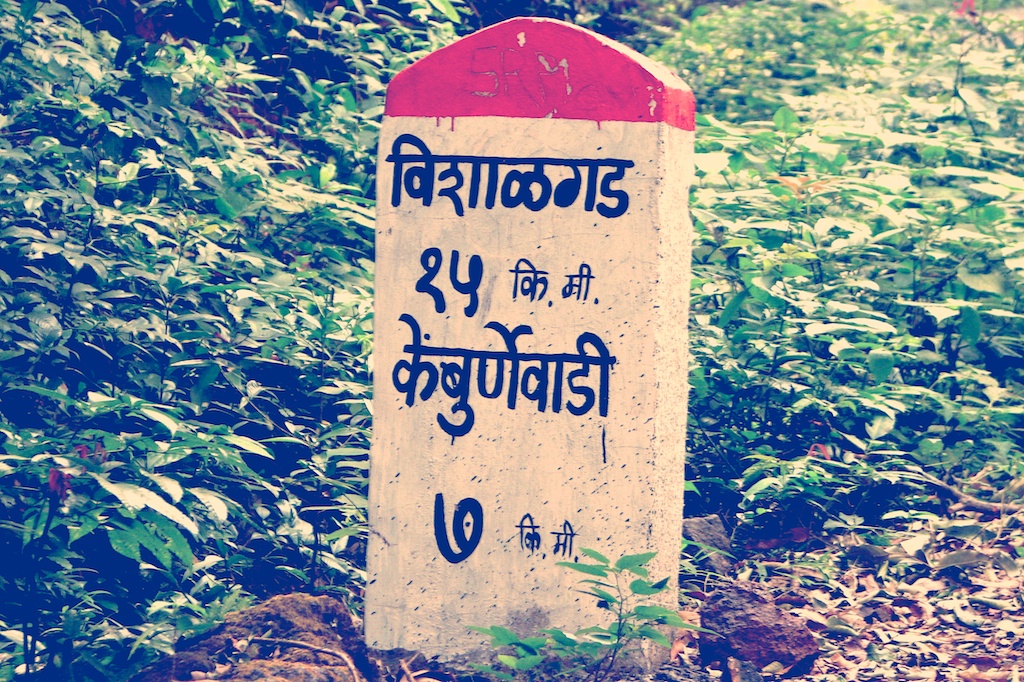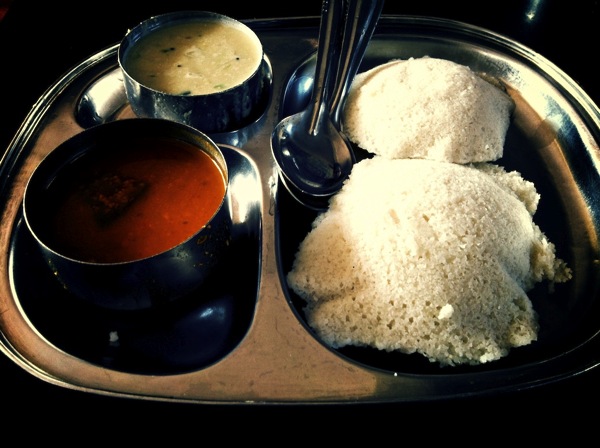One of the primary sources of gleaning the life, styles, and lifestyles of historical figures is through art. Art achieved great heights during the Mughal patronage and continued to flourish under Jaipur and Deccan patronage. After the decline of the Mughal empire, artists sought patronage in Rajasthan and in the Deccan. It is generally assumed Aurangzeb is responsible for the decline of the arts in the Mughal dominions. Yet, there is evidence that it was not always so, and he moved away from arts at a later stage in his life.

Aurangzeb holds court, as painted by (perhaps) Bichitr; Shaistah Khan stands behind Prince Muhammad Azam By Cordanrad [Public domain], via Wikimedia Commons
The decline of the Mughal Empire led to the migration of artists to the Deccan, where they would receive patronage to continue their work. However, we see little development of visual art (specifically, painting), during this period, in Maharashtra and specifically in Western Maharashtra, the seat of the Peshwas. The rule and reign of the Peshwa era, from the mid-1700s, was growing around the same time that the Mughal empire was in decline, so it would seem that the artists would make a beeline to this power centre too. Yet, it seems, that this did not happen. There are paintings of Maratha chieftains and others that were created during this period, but these were primarily created by artists from other dominions and schools of art. It is not until the later decades of the 1700s that we see some development in the painting discipline, by the Marathas. And this development had much to do with the contact of the Marathas with Rajasthan and European influences, than the natural transmigration of artists from the north or from the Deccan. If any significant advances were made (in the art of painting) in this region in the late-17th or the early-18th century, there is a serious lack of evidence, documentation, and research.
Little is known of Maratha painting. A few superb miniatures have come to light, but it is still impossible to reconstruct the extent or the chronology of any school. Probably each centre of Maratha power had its own regional style of portraiture; outside the Deccan the maharajas of Gwalior and Baroda must have also patronised miniature painting which had some links with Deccani styles because of the ruling families’ dynastic ties to Maharashtra. (Architecture and Art of the Deccan Sultanates. New York: Cambridge UP, 1999)
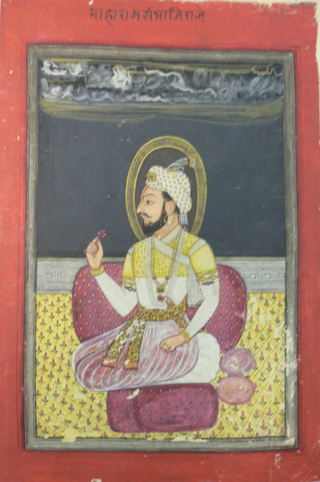
Inscribed above: Maharaja Sambhajiraje. Maratha, late 17th century. Opaque pigments and gold on paper, 146 by 220mm (including border). – See more at: An Album of Maratha and Deccani Paintings
Also, in this post, I refer specifically to Western Maharashtra, because a well-known school of painting was established by the Tanjore branch of the Marathas (1674 – 1855) to promote visual art.
This is not to say that there was no development or evolution of art during the reign of the Marathas. Significant advances were made in performance art and “craft-related art” during this period, which perhaps, will be the subject of another post.
Chh. Shivaji’s preoccupation was primarily with building an empire and his priorities therefore did not include patronage of art. During the establishment of the Maratha supremacy, in the early years, available resources were strategically invested in military affairs and the resurrection and establishment of a people-friendly and functional administrative system. It is no surprise then, that of the available contemporary portraits of Shivaji, not a single one has been painted by a Maratha artist. There is however, another argument that merits discussion. One of the purposes of the paintings in the Mughal Empire was documentation. We see glimpses of the lives, events, and the environment of the Mughal ethos in these paintings. And if documentation be the purpose, the Marathas were definitely not lacking. Visual documentation is cumbersome and time-consuming. The Marathas chose prose over painting, in the form of Bakhars.
The term Bakhar is a metathetical form of the Arabic word Khabar, which means news or report. […] The writers of Bakhars wrote imitating the Tawarikhs of the muslim potentates. […] Rajwade estimates the total number of bakhars at more than two-hundred. Actually only half of them are extant and of these about seventy have so far been published. (The History and Culture of the Indian People: The Maratha Supremacy. Ed. R. C. Majumdar and V. G. Dighe. 3rd ed. Vol. VIII. Bombay: Bharatīya Vidya Bhavan)
From the mid-1700s we see increased interaction of the Marathas with powers, north of the Narmada, when campaigns were led into Malwa, Gujarat, Bundelkhand, and other parts of Madhya Pradesh. Baji Rao I was welcomed in the courts of Rajasthan as the leader of the Marathas. Almost instantly we see the inclusion of a certain Bhojraj, a well-known artist from Jaipur, who was brought to Pune for the paintings at Shaniwar Wada. Also,
Some great paintings were produced, especially at provincial Deccan centres where artists often worked with greater originality than those at Hyderabad, and at the courts of Maratha rulers, who, after decades of guerilla warfare against the Mughals, were now settling down in the cities of the western Deccan. (Architecture and Art of the Deccan Sultanates. New York: Cambridge UP, 1999)
The intrigues of the court were not merely political in nature, they were cultural too. Manuscripts in Maharashtra which were devoid of any illustration were now being worked on by artists from Rajasthan. Miniatures in the Rajput and Pahari style were being created with religious motifs and symbolism.

Madhu Rao Narayan the Maratha Peshwa with Nana Fadnavis and attendants Poona 1792 By James Wales, 1792 ([1]) [Public domain], via Wikimedia Commons
This perhaps marks the reappearance of painting in Maharashtra after a very long time. We see emergence of wall art in places like Wai, Menavali, Motibag, and Satara. We further see the record of names of Maratha artists like Ragho, Tanhaji, Anuprao, and Mankoji.
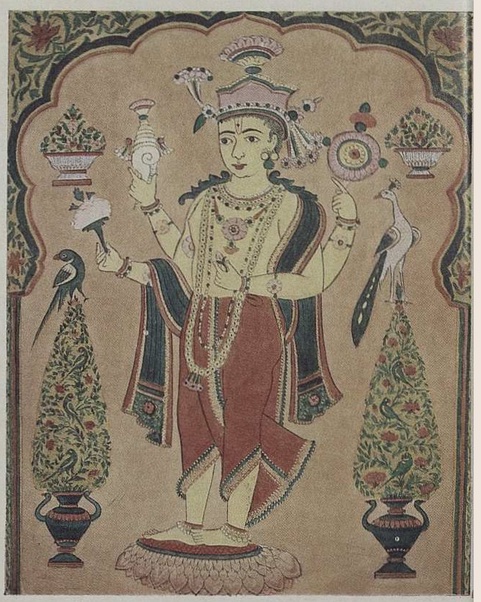
Vishnu, Menavali. Apte, B. K.; Maratha Wall Paintings: Wai, Menavali, Satara, Pune
In the early 1800s, it seems that a “Maratha School” was well-established, however, it never reached the popular heights awarded to the Mughal, Deccan, Rajput, or Pahari schools.

Durbar hall, unidentified, Maratha school, c.1820. By Maratha school [Public domain], via Wikimedia Commons
References
- Pritchett, F. (n.d.). Aurangzeb holds court, as painted by (perhaps) Bichitr; Shaistah Khan stands behind Prince Muhammad Azam. Retrieved April 2, 2015. http://www.columbia.edu/itc/mealac/pritchett/00routesdata/1600_1699/aurangzeb/darbarscene/darbarscene.html
- Chowdry, A. (2008). The studio practices of painters of the Mughal ateliers. In Contributions to the symposium on the care and conservation of Middle Eastern manuscripts: The University of Melbourne, Australia, 26-28 November 2007 (p. 37). Melbourne, Vic.: Centre for Cultural Materials Conservation. http://www.islamicmanuscripts.info/reference/books/Melbourne-2008-Conservation/Melbourne-2008-07-Chowdry.pdf
- “Tanjore Paintings: Marathas.” Wikipedia. Wikimedia Foundation. Web. 2 Apr. 2015. http://en.wikipedia.org/wiki/Tanjore_painting#Marathas
- Kulkarni, AR. Maharashtra in the Age of Shivaji: A Study in Economic History. 2nd ed. Pune: Diamond Publications, 2008. 18. Print.
- Apte, B. K. “Introduction.” Maratha Wall Paintings: Wai, Menavali, Satara, Pune. Bombay: Maharashtra State Board for Literature & Culture, 1988. Ix. Print.
- Parasnis, D. B. “Shanwar Wada.” Poona in the Bygone Days. Bombay: Times, 1921. 8. Print. https://archive.org/details/poonainbygoneday00pararich
- Chavan, Kamal. Maratha Murals: Late Medieval Painting of the Deccan, 1650-1850 A.D. Delhi: B.R. Pub. ;, 1983. 16. Print.
- Michell, George, and Mark Zebrowski. Architecture and Art of the Deccan Sultanates. New York: Cambridge UP, 1999. 248. Print.
- “Language and Literature in the Eighteenth Century.” The History and Culture of the Indian People: The Maratha Supremacy. Ed. R. C. Majumdar and V. G. Dighe. 3rd ed. Vol. VIII. Bombay: Bharatīya Vidya Bhavan, 1977. 666. Print.
